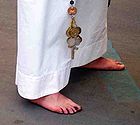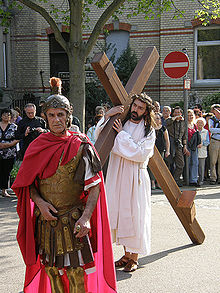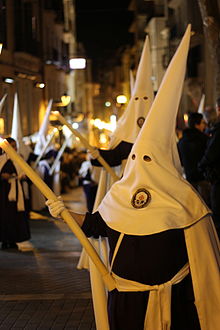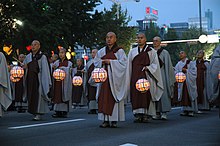procession
A procession (lat. Procedere to advance, to advance; in the meaning of " request procession " also lat. Rogatio from rogare to pray, to ask) is a religious ritual in which a group of people performs a solemn procession or intercourse according to certain rules, usually on foot . In the secular area, they correspond to pageants , parades , funerals and demonstrations .
features
A procession is defined as a “liturgical walking around and around” as a “collective gesture of a cult community”, which recurs regularly as a cult activity. In a pilgrimage , on the other hand, the focus is not on the process of walking and the path, but on the goal, usually a sanctuary . The disorderly influx to a place of worship was (in contrast to the orderly procession or pilgrimage) also called Geläuf (Middle High German run ) (the authorities were "great run", about 1476 to the piper of Niklashause , suspect).
Processions have been practiced in many religions since ancient times. The characteristics of a procession are:
- Involvement of a specific group of believers
- specific, established processional route
- religious dimension of the plot
- If necessary, carrying of cult objects such as shrines or monstrances
- Festive elements like singing
- walking in groups.
Catholicism
There are basic types of processions, the aspects of which often overlap:
- the functional procession at holy mass z. B. the solemn entry and the procession of gifts
- the theophoric (divinity or divine entraining) procession, carry and showing a revered object or symbol, for example the most holy in the Corpus Christi or other sacrament procession , the procession of palms or relics processions
- the mimetic procession (the imitation of a salvation-historical event), z. B. the palm procession , Good Friday procession
- Corridor corridors or corridor rides based on Germanic legal and cult customs, according to which every landowner had to walk around his property once a year in order to maintain the claim to ownership or to avert dangers , e.g. B. corridor or supplication processions , hail processions or equestrian processions in honor of (equestrian) saints or as an Easter ride
- the demonstrative procession, e.g. B. the solemn escort of a newly consecrated bishop to the bishop's house, the procession with the coffin at the church funeral .
- Since the Second Vatican Council , the image of the Church as a “wandering people of God” , whose center is Christ , the “bread of life”, has also become a determining factor .
In the Corpus Christi procession , the theophore (carrying the holy of holies in the monstrance ) and the demonstrative element overlap . With the four times recitation of the gospel and the granting of the sacramental blessing in all directions and over the city, elements of the corridor are also included. In the Rhineland, the Eucharistic procession is in some God costume called (of MHG. Trahte to noun wear ).
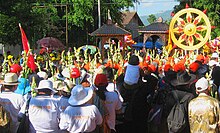
In processions, the process of solemn striding is decisive, while it is characteristic of pilgrimages and pilgrimages that they lead to a - often distant - destination. Pilgrimages are often designed as a procession on the last part before reaching the destination, for example the way from the outskirts of the pilgrimage site to the pilgrimage church (“catching up” the pilgrimage).
Litanies , psalms or hymns can be said or sung or the rosary can be said during a procession . Catholic processions in Central Europe are often accompanied by brass bands. These intone hymns or processional marches , which are intended to promote prayer and facilitate walking together. The roadsides and houses are often decorated with flags , fresh branches and flowers. In the Upper Bavarian Alpine foothills and in the Austrian Alpine region, red so-called "ornamental cloths", often with gold borders, are usually attached to the window sills of the houses instead of the procession flags. In some places ornate flower carpets are laid on the processional path. In the past, "triumphal arches" were also common over the path, today still as the "honor gate" in Mardorf near Amöneburg in Hessen.
Special forms of procession are
- evening light processions in which the procession participants carry candles, often at pilgrimage sites or on the occasion of festival weeks or festival octaves
- the equestrian processions widespread in Upper Swabia, Tyrol, the Black Forest, the Bavarian Forest, Lusatia and Switzerland ( Blutritt in Weingarten , Sankt-Jodok-Ritt in Tännesberg , Antlassritt , Kötztinger Pfingstritt , Tölzer Leonhardifahrt , the Sorbian Easter Riding , in the Rhineland of the Gymnicher Ritt , in Switzerland the driveway ride on the Feast of Ascension in Altishofen , Beromünster , Ettiswil , Grosswangen , Hitzkirch and Sempach ).
- the Echternach jumping procession
- Ship processions, e.g. B. on the Chiemsee , the Staffelsee in Seehausen and on the Rhine the Mülheimer god costume in Cologne-Mülheim .
Hinduism and Buddhism
Also in the Asian religions, such as Processions, such as Hinduism or Buddhism , are an important part of religious life.
history
Greece
Procession were important parts of several ancient cults. The most famous example is the Panathenaic procession from Athens to the Acropolis .
Rome
The pompa at the beginning of circus events ( pompa circensis ) or theatrical performances ( pompa theatri ), carried out in a fixed order by those involved, had been around since the 1st century BC. An integral part of public life. There were also funeral procession ( pompa funebris ) at funeral ceremonies. Imperial triumphal procession ( pompa triumphalis ) formed an important part of the dominate's political life. They became rare in the east since the end of the 4th century, and the emperor's public appearances now mainly took place in the racetrack , the Byzantine equivalent of the football stadium.
Christian East
Christian authors regarded the pagan processions ( pompae ) as a pagan custom, from which a devout Christian would have to stay away because of the cult of emperors and many gods (see pompa diaboli ). At Easter, however, a procession to the Church of the Holy Sepulcher in Jerusalem took place in Christian communities from the 4th century at the latest . Processions also took place when relics were transferred , as John Chrysostom describes for 398 and 403 ( Phocas of Pontus ). The number of participants in such processions was also an important indicator of the strength of factions within the church. Rich furnishings could certainly strengthen the attraction of the respective faith. The transfer of the relics of Chrysostom 438 was also accompanied by a procession.
In 626 a procession took place around the walls of Constantinople to fend off an attack by the Avars and Persians, led by the Patriarch Sergios (610-638), who carried an icon with the image of Christ. Since the beginning of the 9th century, the mantle of the Mother of God from the Church of Theotokos was carried into the Blachernes during such processions .
Under the Patriarch Timothaeus , regular weekly processions are documented for Constantinople from 511 onwards by Theodor Lektor , in this case to the church of Theotokos Chalkoprateia .
Late antiquity
Around 470, Mamertus held a procession in Vienne , as evidenced by a letter from Sidonius Apollinaris , which presumably led around the city walls. The first written procession in Rome took place in 590 under the direction of Gregory the Great to Santa Maria Maggiore and was supposed to ward off the plague .
literature
Monographs and Articles
- Leslie Brubaker: Topography and public space in Constantinople. In: Mayke de Jong, Francis Theuws (Ed.): Topographies of power in the early Middle Ages. Brill, Leiden 2001, ISSN 1386-4165 (Transformation of the Roman world Vol. 6).
- Sabine Felbecker: The procession. Historical and systematic research on a liturgical act of expression. (= Münster theological treatises 39) Altenberge 1995, ISBN 978-3893751143 (743 pages).
- Liutgard Gedeon: Processions in Frankfurt am Main. In: Archive for Middle Rhine Church History , 52 (2000), pp. 11–53.
- Peter Kritzinger: The Cult of Saints and Religious Processions in Late Antiquity and the Early Middle Ages. In: Sarris Peter u. a. (Ed.): An Age of Saints? Brill, Leiden 2011, pp. 36-48.
- Lena Krull: Processions in Prussia. Catholic life in Berlin, Breslau, Essen and Münster in the 19th century. Ergon Verlag, Würzburg 2013, ISSN 2195-1306 , ISBN 978-3-89913-991-4 (Religion and Politics Volume 5).
- Wolfgang Meurer (Hrsg.): People of God on the way. Movement elements in worship. Matthias Grünewald Verlag, Mainz 1989, ISBN 3-7867-1433-9 .
- Stéphane Verhelst: Les processions du cycle annuel dans la liturgie de Jérusalem . In: Bollettino della Badia Greca di Grottaferrata III s. 11 (2014) 217-253.
- Dieter J. Weiss : Processional research and history. In: Yearbook for Folklore NF 27 (2004), pp. 63–79.
- Wilhelm Wörmann : Old processional songs of the diocese of Münster . Diss., University of Münster 1949.
Lexicon article
- Procession . In: Theologische Realenzyklopädie (TRE). Volume 27, de Gruyter, Berlin / New York 1997, ISBN 3-11-015435-8 , pp. 591-597.
- Anton Quack: Procession. I. Religious history . In: Walter Kasper (Ed.): Lexicon for Theology and Church . 3. Edition. tape 8 . Herder, Freiburg im Breisgau 1999, Sp. 678 f .
- Sabine Felbecker: Procession. II. Liturgical . In: Walter Kasper (Ed.): Lexicon for Theology and Church . 3. Edition. tape 8 . Herder, Freiburg im Breisgau 1999, Sp. 679 f .
- Fred G. Rausch: Procession. III. Piety history . In: Walter Kasper (Ed.): Lexicon for Theology and Church . 3. Edition. tape 8 . Herder, Freiburg im Breisgau 1999, Sp. 680 f .
Web links
Individual evidence
- ^ Wolfgang Brückner : cultural techniques. Non-verbal communication, legal symbols, religio carnalis. Würzburg 2000, quoted by: Dieter J. Weiß : Processional research and history. In: Jahrbuch für Volkskunde NF 27 (2004), pp. 63–79, here pp. 63f., Note 5.
- ^ Wolfgang Schneider: Folk culture and everyday life. In: Ulrich Wagner (Hrsg.): History of the city of Würzburg. 4 volumes, Volume I-III / 2, Theiss, Stuttgart 2001–2007, Volume 1 (2001): From the beginnings to the outbreak of the Peasants' War. ISBN 3-8062-1465-4 , pp. 491-514 and 661-665, here: pp. 493 f. and 660.
- ^ Lena Krull: Processions in Prussia. Catholic life in Berlin, Breslau, Essen and Münster in the 19th century. Würzburg 2013, p. 15.
- ↑ Manfred Becker-Huberti : Celebrations, festivals, seasons. Living customs throughout the year , Freiburg-Basel-Vienna 1998, ISBN 3-451-27702-6 , 300, 373.
- ^ Kluge, Friedrich: Etymological Dictionary of the German Language , 23rd edition, Berlin 1999, ISBN 3-11-016392-6 , 830
- ↑ Manfred Becker-Huberti: Celebrations, festivals, seasons. Living customs throughout the year , Freiburg-Basel-Vienna 1998, ISBN 3-451-27702-6 , 341
- ↑ luzern.com: Access tour ( memento of the original from September 15, 2016 in the Internet Archive ) Info: The archive link was inserted automatically and has not yet been checked. Please check the original and archive link according to the instructions and then remove this notice.
See also
